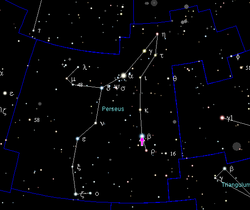
Algol
Did you know...
The articles in this Schools selection have been arranged by curriculum topic thanks to SOS Children volunteers. SOS mothers each look after a a family of sponsored children.
| Observation data Epoch J2000 Equinox J2000 |
|
|---|---|
| Constellation | Perseus |
| Right ascension | 03h 08m 10.1315s |
| Declination | +40° 57′ 20.332″ |
| Apparent magnitude (V) | 2.12 |
| Characteristics | |
| Spectral type | B8V (A) /K02IV (B) /A5V (C) |
| U−B colour index | -0.37 |
| B−V colour index | -0.05 |
| Variable type | Eclipsing binary |
| Astrometry | |
| Radial velocity (Rv) | 3.7 km/s |
| Proper motion (μ) | RA: 2.39 mas/ yr Dec.: -1.44 mas/ yr |
| Parallax (π) | 35.14 ± 0.90 mas |
| Distance | 93 ± 2 ly (28.5 ± 0.7 pc) |
| Absolute magnitude (MV) | -0.15 |
| Details | |
| Mass | 3.59/0.79/1.67 M☉ |
| Radius | 2.3/3.0/0.9 R☉ |
| Luminosity | 98/3.4/4.1 L☉ |
| Temperature | 12,000/4,500/8,500 K |
| Metallicity | Not available |
| Rotation | 65 km/s. |
| Age | < 3 × 108 years |
| Other designations | |
|
Algol, Gorgona, Gorgonea Prima, Demon Star, El Ghoul, 26 Per, GJ 9110, HR 936, BD +40°673, HD 19356, GCTP 646.00, SAO 38592, FK5 111, Wo 9110, ADS 2362, WDS 03082+4057A, HIP 14576.
|
|
Algol (β Per / Beta Persei), known colloquially as the Demon Star, is a bright star in the constellation Perseus. It is one of the best known eclipsing binaries, the first such star to be discovered, and also one of the first (non- nova) variable stars to be discovered. Algol is actually a three-star system (Beta Persei A, B and C) in which the large and bright primary Beta Persei A is regularly eclipsed by the dimmer Beta Persei B. Thus, Algol's magnitude is usually near-constant at 2.1, but regularly dips to 3.4 every 2 days, 20 hours and 49 minutes during the roughly 10-hour long partial eclipses. There is also a secondary eclipse when the brighter star occults the fainter secondary. This secondary eclipse can only be detected photoelectrically.
Observation history
The variability of Algol was first recorded in 1667 by Geminiano Montanari, but it is probable that this property was noticed long before this time. The first person to propose a mechanism for the variability of this star was the British amateur astronomer John Goodricke. In May, 1783 he presented his findings to the Royal Society, suggesting that the periodic variability was caused by a dark body passing in front of the star (or else that the star itself has a darker region that is periodically turned toward the Earth.) For his report he was awarded the Copley Medal.
In 1881, the Harvard astronomer Edward Pickering presented evidence that Algol was actually an eclipsing binary. This was confirmed a few years later, in 1889, when the Potsdam astronomer Hermann Vogel found periodic doppler shifts in the spectrum of Algol, inferring variations in the radial velocity of this binary system. Thus Algol became one of the first known spectroscopic binaries.
System
As an eclipsing binary, it is actually two stars in close orbit around one another. Because the orbital plane coincidentally contains the Earth's line of sight, the dimmer star (Algol B) passes in front of the brighter star (Algol A) once per orbit, and the amount of light reaching Earth is temporarily decreased. To be more precise, however, Algol happens to be a triple star system: the eclipsing binary pair is separated by only 0.062 AU, while the third star (Algol C) is at an average distance of 2.69 AU from the pair and the mutual orbital period is 681 days (1.86 years). The total mass of the system is about 5.8 solar masses, and the mass ratios of A, B and C are about 4.5 : 1 : 2.
| Components | Semimajor axis | Ellipticity | Period | Inclination |
|---|---|---|---|---|
| A—B | 0.00218″ | 0.00 | 2.87 days | 97.69° |
| (AB)—C | 0.09461″ | 0.225 | 680.05 days | 83.98° |
Studies of Algol led to the Algol paradox in the theory of stellar evolution: although components of a binary star form at the same time, and massive stars evolve much faster than the less massive ones, it was observed that the more massive component Algol A is still in the main sequence, while the less massive Algol B is a subgiant star at a later evolutionary stage. The paradox can be solved by mass transfer: when the more massive star became a subgiant, it filled its Roche lobe, and most of the mass was transferred to the other star, which is still in the main sequence. In some binaries similar to Algol, a gas flow can actually be seen.
This system also exhibits variable activity in the form of x-ray and radio flares. The former is thought to be caused by the magnetic fields of the AB components interacting with the mass transfer. The radio emissions may be created by magnetic cycles similar to sunspots, but, as the magnetic fields around these stars are up to ten times stronger than that of the Sun, these radio flares are more powerful and longer lasting.
Algol is 92.8 light years from Earth; however, about 7.3 million years ago it passed within 9.8 light years and its apparent magnitude was approximately −2.5, considerably brighter than Sirius is today. Because the total mass of the system is 5.8 solar masses, and despite the fairly large distance at closest approach, this may have been enough to perturb the solar system's Oort cloud slightly and to increase the number of comets entering the inner solar system. However, the actual increase in net cratering rate is believed to have been quite small.
Etymology and cultural significance
The name Algol derives from Arabic رأس الغول ra's al-ghūl : head (ra's) of the ogre (al-ghūl) (see "the ghoul") which was probably given due to its peculiar behaviour. The English names of Demon Star and Blinking Demon are direct translations. In Hebrew folklore it was known as Rōsh ha Sāṭān 'Satan's Head', via Edmund Chilmead, who called it 'Divels head' or Rosch hassatan. A Latin term from the 16th century was Caput Larvae 'Spectre's Head'. It was also linked with Lilith. In the constellation Perseus, it represents the eye of the Gorgon Medusa. Hipparchus and Pliny made this a separate, though connected, constellation.
It is known as 大陵五 (the Fifth Star of the Mausoleum) in Chinese astronomy, and also bore the grim name Tseih She 'Piled up corpses'.
Astrology
Astrologically, Algol is considered the most unfortunate star in the sky. In the Middle Ages it was one of the 15 Behenian stars, associated with the diamond and hellebore, and marked with the kabbalistic sign:
Modern fiction
One of the earliest films about alien invasion was a 1920 German silent film titled Algol. Renowned at the time for its sets, it featured Emil Jannings as Mephisto, an alien from Algol. All prints of the film are now lost.
- The Hitchhiker's Guide to the Galaxy mentions Algol several times.
- The sci-fi comedy book Bikini Planet features aliens from Algol. They are a feminist society and all have lizard-like features.
- In the short story, Beyond the Wall of Sleep, by H. P. Lovecraft, a nova is mentioned as having taken place near Algol on February 22, 1901; this nova is, according to the story, the result of an epic space battle between two incorporeal beings, known in the story as the 'entity' and the 'oppressor.'
- In the Sega video game series Phantasy Star, the star system which the series takes place in is called the Algol Solar System.


